GENERAL
What is Baltic Property Trust: Complete 2025 Investor Guide
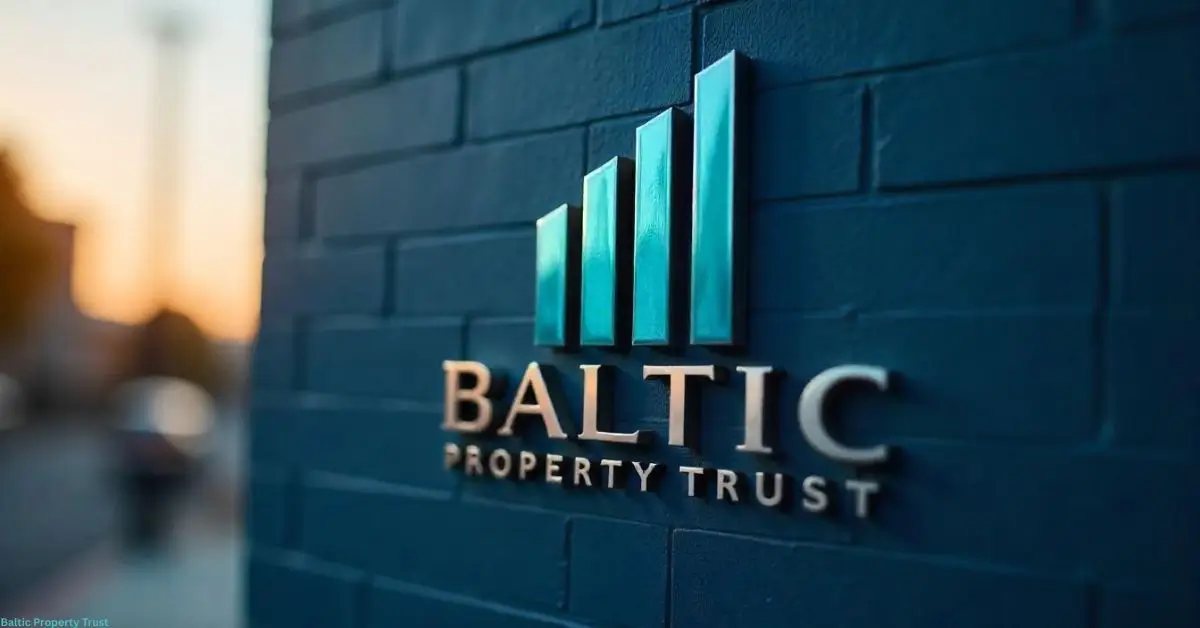
For years, Baltic Property Trust (BPT) shaped how institutional investors and private funds accessed commercial real estate in Northern Europe. Founded in 2002 in Copenhagen, the firm built a portfolio worth more than €1 billion, spread across Estonia, Latvia, Lithuania, and Poland. At its peak, BPT managed over 1 million square meters of commercial property. According to Newsec, its 2022 acquisition of BPT’s property arm cemented it as the largest independent property manager in the Baltic region.
For investors, the real question isn’t just “what was Baltic Property Trust?” But what happened to it, who owns its legacy, and what alternatives exist today?
Quick Answer
Baltic Property Trust no longer exists as a single company.
Its property management arm was acquired by Newsec in 2022, while its asset management division was rebranded as Northern Horizon Capital. At its peak, the trust managed €1bn+ in Baltic and Polish commercial assets, including landmark deals like the €168m Warsaw sale-leaseback with France Telecom.
How Did Baltic Property Trust Rise, Rebrand, and Get Acquired?
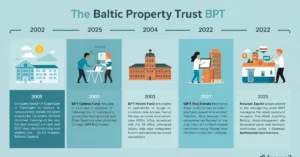
BPT started in 2002 to capture post-EU accession growth in the Baltics and Poland. It created funds that pooled investor capital into regional commercial properties offices, retail, logistics.
- 2002: Company founded in Copenhagen.
- 2005: Second fund launched after strong investor demand (Private Equity International).
- 2008: BPT Optima Fund completed a €168m Warsaw office transaction with France Telecom (IPE Real Assets).
- 2015: BPT Real Estate sold to BaltCap.
- 2022: Newsec acquired BPT Real Estate, becoming the largest independent manager in the Baltics.
- Ongoing: Asset management continued under the rebranded Northern Horizon Capital.
Key Inatke: The trust did not collapse—it evolved. Its arms were sold, rebranded, or absorbed, reflecting deliberate strategic moves.
Portfolio Deep Dive: Scale, Key Assets, and Financial Performance
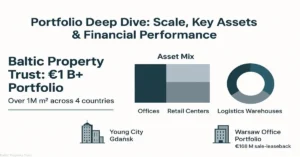
At its peak, Baltic Property Trust controlled over €1bn in assets, spanning four countries.
- Portfolio size: More than 1 million square meters.
- Notable projects:
- Young City Gdansk — a large waterfront mixed-use development.
- Warsaw Office Portfolio — €168m sale-leaseback with France Telecom (2008).
- Sectors covered: Offices, retail centers, logistics warehouses.
This scale positioned BPT as both a Baltic REIT alternative and a regional yield trust, though structured as private funds.
Investor insight: BPT’s large-scale projects show it was never a niche player it was a full institutional platform.
(Visual fit: data chart of sqm + asset mix)
Myth vs Fact: Clarifying Common Misconceptions
| Myth | Fact |
| BPT only operated in the Baltics. | It had significant investments in Poland. |
| The company went bankrupt. | It was strategically split, sold, and rebranded. |
| Its projects were small. | BPT managed landmark projects like Young City and Warsaw’s office portfolio. |
Takeaway: Misconceptions stem from the complex divestment timeline, not poor performance.
Who Are Baltic Property Trust’s Successors Today?
Today, BPT’s DNA lives on in two entities:
- Newsec acquired BPT Real Estate in 2022. It is now the largest independent property manager in the Baltics. It focuses on property management, valuation, and advisory.
- Northern Horizon Capital formerly BPT’s asset management division. It continues to launch and manage real estate funds in the Nordic-Baltic region, with a strong ESG lens.
Key Intake: If you want to know who “owns” BPT today Newsec runs the property side, Northern Horizon manages the fund side.
Comparison Table: BPT vs Modern Baltic Fund Vehicles
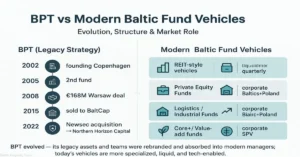
| BPT (Historical) | Northern Horizon Capital | Other Baltic PE Funds | |
| Investment Focus | Pan-Baltic & Poland Commercial | Nordic-Baltic Real Estate | Residential / Commercial niches |
| Investor Access | Private Funds | Institutional / Professional | Limited Partners |
| Target Yield | N/A (Historical) | Disclosed privately | Varies |
| Key Differentiator | First-mover regional fund | ESG integration, modern structures | Local specialization |
Why it matters: Investors comparing past to present can see how access, governance, and yield focus have evolved.
How-To: Analyze Baltic Real Estate Investment Opportunities Post-BPT
If you’re eyeing modern funds or REIT-like vehicles in the region, use this tactical lens:
- Evaluate the management team. Look for BPT lineage or proven Baltic track records.
- Scrutinize asset strategy. Does it target logistics, offices, or mixed-use—and does that align with market trends?
- Check fee structure and exit horizon. Don’t underestimate fees’ impact on yield.
- Assess inflation protection. The Baltics have cyclical economies; look for funds using indexed rents or long leases.
Note: Truth is, most investors skip this checklist but it’s the difference between stable yield and risky exposure.
Sources
- IPE Real Assets: Coverage of BPT Optima’s landmark €168m Warsaw sale-leaseback deal.
- Private Equity International: Report on Baltic Property Trust’s plans for a new pan-Baltic fund.
- Newsec: Press release on acquiring BPT Real Estate.
- Northern Horizon Capital: Corporate profile and Baltic investment focus.
- Industry Reports: Independent analyses highlighting BPT’s role in shaping Baltic and Polish commercial property markets.
FAQ’s
What is Baltic Property Trust known for?
It was one of the first major real estate investment groups in the Baltics and Poland, managing €1bn+ in assets.
Who bought Baltic Property Trust’s property management arm?
It was acquired by BaltCap in 2015 and later sold to Newsec in 2022.
Does Baltic Property Trust still exist?
No, it was dissolved. Its operations continue through Newsec and Northern Horizon Capital.
What was the largest deal BPT executed?
The €168m sale-leaseback of three Warsaw office buildings with France Telecom in 2008.
How can I invest in Baltic real estate now?
You can access funds via Northern Horizon Capital or other Baltic PE funds targeting offices, retail, or logistics.
Author Bio
Lukas Rainer is a European real estate investment analyst with 12 years of experience covering private equity funds and cross-border REIT strategies. He specializes in Baltic and Nordic markets.
GENERAL
What Is Çeciir? Discover the Ancient Grain Taking Modern Kitchens by Storm
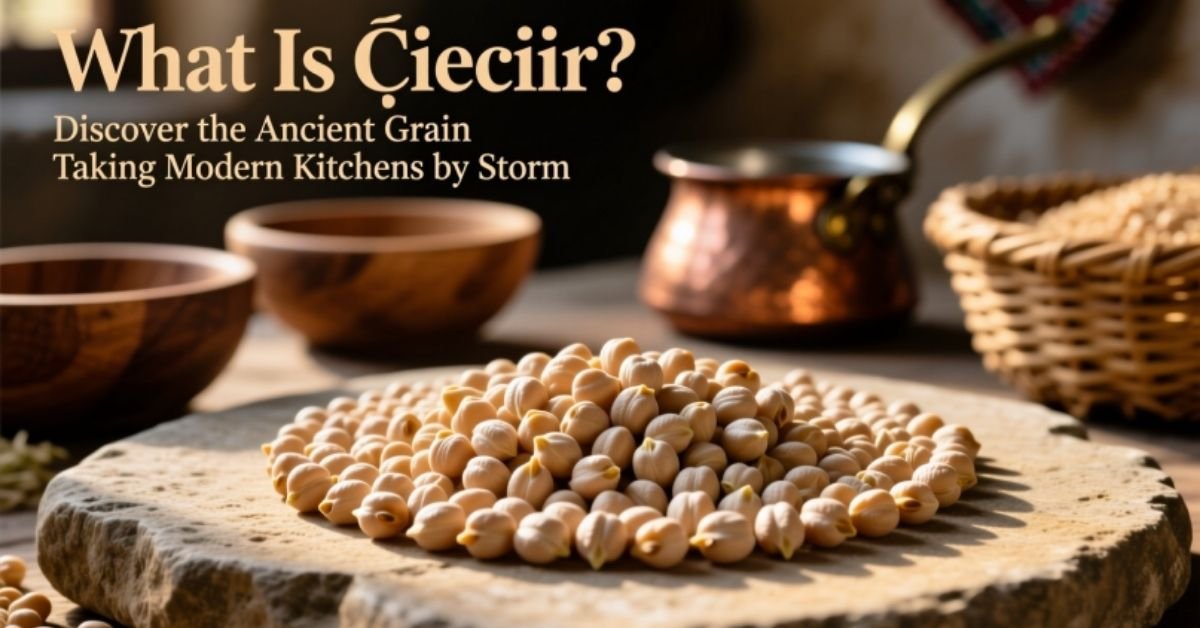
In recent years, health-conscious eaters and adventurous home cooks have turned to forgotten grains for both nutrition and flavor. Among these rediscovered treasures is çeciir—a little-known but incredibly wholesome grain that’s gaining attention for its rich taste, impressive health profile, and culinary flexibility. Though it may sound unfamiliar, çeciir has deep roots in traditional diets and is now finding its way into modern kitchens worldwide.
This guide will walk you through everything you need to know about çeciir: where it comes from, why it’s good for you, how to cook it, and why food experts are calling it a “supergrain” of the future.
The Origins and History of Çeciir
Çeciir (pronounced “cheh-cheer”) is an ancient cereal grain believed to have originated in the highlands of Central Anatolia thousands of years ago. Historical records suggest it was cultivated by early agrarian communities for its resilience to harsh climates and long shelf life. Unlike modern wheat, which has been heavily hybridized, çeciir remains largely unchanged—preserving its original genetic integrity and nutritional value.
For centuries, it was a staple in rural diets, often ground into flour for flatbreads or simmered into hearty porridges. However, with the rise of industrial agriculture in the 20th century, çeciir nearly vanished from mainstream use. Thanks to a global revival of heritage grains, çeciir is now being reintroduced as a sustainable and healthful alternative to refined grains.
Why Çeciir Stands Out Nutritionally
One of the biggest reasons çeciir is capturing attention is its exceptional nutritional composition. It’s naturally high in plant-based protein, dietary fiber, and essential minerals like magnesium, iron, and zinc. Unlike many common grains, it has a low glycemic index, making it a smart choice for those managing blood sugar levels.
Additionally, çeciir is naturally gluten-free, offering a safe and tasty option for people with gluten sensitivities or celiac disease. Its balanced amino acid profile also makes it a valuable addition to vegetarian and vegan diets, where complete protein sources can be limited.
Key Nutritional Benefits of Çeciir
- Rich in complex carbohydrates for sustained energy
- Contains over 10% plant-based protein by weight
- High in soluble and insoluble fiber for digestive health
- Packed with antioxidants that support cellular health
- Naturally free from gluten and common allergens
How to Cook and Use Çeciir in Everyday Meals
Cooking with çeciir is simple and rewarding. The whole grain resembles tiny amber beads and has a slightly chewy texture with a warm, nutty flavor—similar to farro or freekeh, but milder. To prepare it, rinse 1 cup of çeciir and simmer in 2.5 cups of water or broth for about 25–30 minutes until tender. Drain any excess liquid, and it’s ready to use.
Çeciir shines in a wide range of dishes. Toss it into salads for extra heartiness, stir it into soups for thickness, or serve it as a base for grain bowls topped with roasted vegetables and tahini dressing. It can also be ground into flour for baking rustic breads, muffins, or pancakes with a subtle earthy note.
Where to Buy Çeciir and What to Look For
While still not found in every supermarket, çeciir is increasingly available in health food stores, specialty grocers, and online retailers. Look for packages labeled “whole grain çeciir” or “organic çeciir” to ensure quality and purity. Avoid products with added preservatives or fillers.
Because it’s a niche grain, prices may be slightly higher than common grains like rice or quinoa—but its nutrient density and versatility make it a worthwhile investment. Buying in bulk can also reduce costs and support sustainable packaging practices.
Sustainability and Ethical Farming Behind Çeciir
Another compelling reason to embrace çeciir is its environmental footprint. It requires significantly less water than wheat or rice and thrives in poor soils without heavy fertilizer use. Many small-scale farmers who grow çeciir use regenerative agricultural methods, helping preserve biodiversity and soil health.
By choosing çeciir, consumers support traditional farming communities and promote crop diversity—a critical step in building a more resilient global food system. In a world increasingly focused on sustainability, this humble grain offers both flavor and conscience.
Final Thoughts: Why Çeciir Deserves a Place in Your Pantry
Whether you’re seeking better nutrition, exploring global cuisines, or simply tired of the same old grains, çeciir offers a delicious and meaningful alternative. Its blend of history, health, and culinary adaptability makes it more than just a trend—it’s a return to food that nourishes both body and planet.
As awareness grows, çeciir is likely to become a kitchen staple for mindful eaters everywhere. So why not give it a try? A single pot of this golden grain might just inspire your next favorite meal.
Frequently Asked Questions (FAQs)
1. Can çeciir be used in place of rice in recipes?
Yes—çeciir works well as a rice substitute in pilafs, stir-fries, and stuffed peppers due to its similar texture when cooked.
2. How long does cooked çeciir last in the fridge?
Stored in an airtight container, it stays fresh for up to 5 days and can be reheated with a splash of water.
3. Is çeciir safe for people with nut allergies?
Yes, despite its nutty flavor, çeciir is a grain and not related to tree nuts or peanuts.
4. Does çeciir need to be soaked before cooking?
Soaking is optional but can reduce cooking time by 5–10 minutes and improve digestibility.
5. Can pets eat çeciir?
In small, plain portions, yes—some dog and bird foods include ancient grains like çeciir for added fiber and nutrients.
ENTERTAINMENT
Wife Pt2 – Malena Doll: The Story and Its Cultural Impact

In the world of digital storytelling, certain narratives capture attention not just for their drama, but for the deeper questions they raise about trust, identity, and human choices. One such title that has drawn curiosity is “Unfaithful Wife Pt2 – Malena Doll.” While it may sound like a sensational headline, this story—often shared through illustrated fiction, webcomics, or short-form drama content—uses its characters to explore complex emotional landscapes. This article offers a respectful, spoiler-aware overview of its themes, cultural context, and why stories like this continue to engage readers worldwide.
It’s important to note that Unfaithful Wife Pt2 – Malena Doll is a work of fiction, not a real-life account. Understanding it as creative storytelling helps frame its purpose: to provoke thought, not to promote judgment.
What Is “Unfaithful Wife Pt2 – Malena Doll”?
“Unfaithful Wife Pt2 – Malena Doll” is typically presented as a continuation of a dramatic narrative centered on a woman named Malena, often depicted as elegant, introspective, and caught in a web of emotional conflict. The “doll” reference in the title is symbolic—suggesting themes of control, appearance versus reality, or the pressure to conform to societal expectations in relationships.
The story unfolds through visual panels or written episodes, common in online fiction platforms. It delves into Malena’s internal struggles, her marriage, and the choices that lead her down a path of secrecy. Rather than glorifying infidelity, many interpretations use the plot to examine loneliness, miscommunication, and the consequences of unmet emotional needs.
Why Does This Story Resonate with Audiences?
Fictional tales like Unfaithful Wife Pt2 – Malena Doll tap into universal human experiences. Many readers see reflections of their own relationships—not in the actions, but in the feelings of isolation, longing, or regret. The story’s popularity stems less from scandal and more from its emotional authenticity.
Additionally, the character of Malena is often portrayed with nuance. She isn’t simply “good” or “bad”; she’s layered, flawed, and human. This complexity invites empathy rather than condemnation, encouraging audiences to think beyond black-and-white morality.
Common Themes in the Narrative
- Emotional disconnection in long-term relationships
- The illusion of perfection in marriage and social image
- Personal agency and the cost of choices
- Redemption and consequence as intertwined outcomes
- Symbolism of the “doll” representing performative femininity or suppressed identity
The Role of Symbolism: Why “Doll”?
The word “doll” in Unfaithful Wife Pt2 – Malena Doll is rarely literal. Instead, it functions as a metaphor. In literature and visual storytelling, dolls often symbolize passivity, objectification, or the loss of autonomy. Malena may appear composed and beautiful on the outside—like a porcelain doll—but inside, she’s yearning for authenticity, voice, or freedom.
This symbolism resonates especially in discussions about gender roles. The story subtly critiques expectations placed on women to be flawless partners while denying them space to express vulnerability or desire. By naming her “Malena Doll,” the narrative highlights the tension between who she is and who others expect her to be.
Responsible Engagement with Fictional Drama
While Unfaithful Wife Pt2 – Malena Doll is compelling, it’s essential to engage with such content mindfully. These stories are not endorsements of betrayal but explorations of human frailty. They work best when they inspire conversations about communication, emotional honesty, and relationship health.
Creators of such narratives often aim to entertain, yes—but also to reflect societal patterns. Readers can gain insight by asking: What led to this moment? Could this have been prevented? What would healing look like? These questions turn passive consumption into active reflection.
The Bigger Picture: Storytelling in the Digital Age
Online platforms have democratized storytelling, allowing creators to share intimate, character-driven dramas like Unfaithful Wife Pt2 – Malena Doll with global audiences. Unlike traditional media, these formats often blend visual art, dialogue, and pacing in ways that feel immediate and personal.
However, with accessibility comes responsibility. Viewers should distinguish between fiction and reality, and avoid using dramatic plots to stereotype real people. Healthy relationships are built on trust and dialogue—something even the most gripping fiction can’t replace.
Final Thoughts
Unfaithful Wife Pt2 – Malena Doll is more than a provocative title—it’s a window into the emotional complexities many face in private. By approaching it with empathy and critical thinking, readers can appreciate its artistry while reinforcing the values that sustain real-world relationships: honesty, respect, and mutual care.
Whether you encounter this story on a webcomic site, social media, or a fiction app, remember: it’s a mirror, not a manual.
Frequently Asked Questions (FAQs)
1. Is “Unfaithful Wife Pt2 – Malena Doll” based on a true story?
No, it is a fictional narrative created for entertainment and thematic exploration.
2. Where can I read the full story legally?
It may be available on licensed digital fiction or webcomic platforms—always use official sources to support creators.
3. Is there a Part 1 to this story?
Yes, “Unfaithful Wife Pt1” typically sets up Malena’s background and marital dynamics before Part 2 unfolds.
4. Are there content warnings for this story?
Yes—it often includes themes of emotional distress, betrayal, and mature relationship issues.
5. Who is the creator of Malena Doll?
The original creator varies by platform; many such stories are produced by independent digital artists or writers under pseudonyms.
a doll
GENERAL
Explore Taipei with DaytimeStar.com Taipei Self-Driving Gharry Adventures

Imagine cruising through the bustling streets of Taipei not in a standard rental car, but in a charming, modern twist on a classic horse-drawn carriage—now electric, self-driven, and designed for urban exploration. This is the magic of the Taipei self-driving gharry, a novel transportation concept gaining popularity among tourists and locals alike. And for the most reliable, up-to-date information on how to book, operate, and enjoy this unique ride, DaytimeStar.com has become a go-to resource.
Unlike traditional tours that follow rigid schedules, the self-driving gharry offers freedom, fun, and a touch of whimsy. Whether you’re weaving through night markets, pausing at historic temples, or enjoying panoramic views from Yangmingshan, this eco-friendly vehicle puts you in control of your Taipei adventure.
What Is a Self-Driving Gharry in Taipei?
A “gharry” historically refers to a horse-drawn carriage once common in parts of Asia during the colonial era. In Taipei, the term has been reimagined: the Taipei self-driving gharry is a compact, electric, two-seater vehicle styled to evoke vintage charm but equipped with modern navigation, safety features, and zero emissions. It’s not autonomous—it’s self-driven by you, the rider—making it more like a stylish micro-EV than a robot taxi.
These gharrys are designed for short-distance urban tourism, with intuitive controls, GPS guidance, and pre-set scenic routes. They’re perfect for couples, solo travelers, or friends looking for a memorable, low-stress way to see the city without navigating public transit or hailing cabs.
Why DaytimeStar.com Is Your Best Guide
When planning your gharry experience, DaytimeStar.com: Taipei self-driving gharry coverage stands out for its clarity, real-time updates, and traveler-focused tips. The site breaks down everything from rental locations and pricing to recommended itineraries and seasonal availability. Unlike generic travel blogs, DaytimeStar.com often includes firsthand user reviews, route maps, and even multilingual support guides.
Moreover, the platform partners with official gharry operators to ensure accurate booking links and safety certifications. This makes DaytimeStar.com not just an information hub, but a trusted bridge between curious travelers and authentic Taipei experiences.
Key Features of the Taipei Self-Driving Gharry
- Eco-Friendly Design: Fully electric with zero tailpipe emissions
- Easy Operation: No special license needed; simple joystick or pedal controls
- Themed Routes: Choose from cultural, culinary, or nature-focused paths
- Smart Tech: Built-in GPS, voice narration, and emergency assistance
- Photo-Ready Style: Retro-modern design perfect for social media moments
Popular Routes to Explore via Self-Driving Gharry
Thanks to guidance from DaytimeStar.com: Taipei self-driving gharry recommendations, travelers can select from several curated routes. One favorite loops through Ximending and Longshan Temple, blending shopping, street food, and spiritual heritage. Another scenic option climbs gently into the hills of Beitou, passing hot springs and lush trails.
For evening explorers, a night route covers Raohe Night Market, Taipei 101 light shows, and riverside parks—ideal for capturing the city’s electric energy after dark. Each route includes designated gharry parking and charging stations, ensuring a smooth, uninterrupted journey.
How to Book and Operate Your Gharry
Booking a Taipei self-driving gharry is straightforward through official kiosks or via links featured on DaytimeStar.com. Most operators require a valid driver’s license (international permits accepted) and a brief 10-minute orientation session. Helmets are provided, and speed is capped at 25 km/h for safety in urban zones.
The vehicles are equipped with touchscreen dashboards that display your route, battery level, and nearby points of interest. If you stray off-path or need help, a 24/7 support line is accessible with one tap. Payment is typically hourly, with discounts for half-day or full-day rentals.
Safety, Sustainability, and Local Impact
Beyond novelty, the self-driving gharry initiative supports Taipei’s green mobility goals. By replacing short car trips with quiet, clean electric rides, the program reduces congestion and pollution. DaytimeStar.com highlights how each gharry rental contributes to local eco-tourism funds, helping preserve cultural sites and community markets.
Safety remains a top priority. All gharrys undergo daily inspections, and riders must pass a quick digital quiz before departure. Child seats and accessibility options are also available upon request—details clearly outlined on DaytimeStar.com: Taipei self-driving gharry pages.
Final Thoughts: A New Way to See Taipei
The Taipei self-driving gharry isn’t just transport—it’s an experience that blends nostalgia, innovation, and sustainability. With DaytimeStar.com as your guide, you gain access to practical tools, insider tips, and confidence to explore the city at your own pace. Whether you’re a first-time visitor or a returning traveler, this unique ride offers a fresh perspective on Taipei’s dynamic spirit.
So next time you plan a trip to Taiwan’s capital, skip the crowded buses and impersonal scooters. Hop into a gharry, follow a route from DaytimeStar.com, and let Taipei reveal its secrets—one charming street at a time.
Frequently Asked Questions (FAQs)
1. Do I need a Taiwanese driver’s license to operate a self-driving gharry?
No—an international driving permit or valid home-country license is sufficient for short-term rentals.
2. Can two adults comfortably fit in one gharry?
Yes, most models are designed for two passengers with light luggage or shopping bags.
3. Are gharrys available during rainy days?
Yes—they come with retractable canopies or enclosed cabins, and DaytimeStar.com provides weather advisories.
4. Is there an age limit to drive a Taipei self-driving gharry?
Drivers must be at least 18 years old and able to understand basic vehicle instructions.
5. Can I extend my rental time on the spot?
Yes, if the gharry isn’t reserved by another user, you can extend via the in-vehicle app or operator hotline.
-

 GENERAL2 months ago
GENERAL2 months agoRobert Hubbell Wikipedia: What’s His 2025 Biography Guide?
-

 EDUCATION5 months ago
EDUCATION5 months agoJay Kuo Substack: Unpacking the Voice of Legal Insight
-

 GENERAL5 months ago
GENERAL5 months agoDream Cake: A Decadent Delight Worth Savoring
-

 EDUCATION5 months ago
EDUCATION5 months agoEconomic Blackout Results: The Financial Domino Effect
-

 GENERAL5 months ago
GENERAL5 months agoChris Hedges Substack: A Voice of Dissent in the Digital Age
-

 TECHNOLOGY5 months ago
TECHNOLOGY5 months agoHow to Cancel Substack Subscription
-

 GENERAL5 months ago
GENERAL5 months agoMax Azzarello Substack: Inside the Mind of a Radical Truth-Seeker
-

 ENTERTAINMENT5 months ago
ENTERTAINMENT5 months agoTyler the Creator Dad Truth
